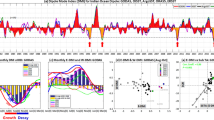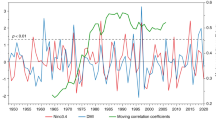Abstract
After its maturity, El Niño usually decays rapidly in the following summer and evolves into a La Niña pattern. However, this was not the case for the 2018/19 El Niño event. Based on multiple reanalysis data sets, the space-time evolution and triggering mechanism for the unusual second-year warming in late 2019, after the 2018/19 El Niño event, are investigated in the tropical Pacific. After a short decaying period associated with the 2018/19 El Niño condition, positive sea surface temperature anomalies (SSTAs) re-intensified in the eastern equatorial Pacific in late 2019. Compared with the composite pattern of El Niño in the following year, two key differences are evident in the evolution of SSTAs in 2019. First, is the persistence of the surface warming over the central equatorial Pacific in May, and second, is the re-intensification of the positive SSTAs over the eastern equatorial Pacific in September. Observational results suggest that the re-intensification of anomalous westerly winds over the western and central Pacific, induced remotely by an extreme Indian Ocean Dipole (IOD) event, acted as a triggering mechanism for the second-year warming in late 2019. That is, the IOD-related cold SSTAs in the eastern Indian Ocean established and sustained anomalous surface westerly winds over the western equatorial Pacific, which induced downwelling Kelvin waves propagating eastward along the equator. At the same time, the subsurface ocean provided plenty of warm water in the western and central equatorial Pacific. Mixed-layer heat budget analyses further confirm that positive zonal advection, induced by the anomalous westerly winds, and thermocline feedback played important roles in leading to the second-year warming in late 2019. This study provides new insights into the processes responsible for the diversity of El Niño evolution, which is important for improving the physical understanding and seasonal prediction of El Niño events.
摘要
发生在赤道中东太平洋的厄尔尼诺事件在当年冬季发展成熟之后, 往往于次年春夏季快速衰减并转入拉尼娜状态, 2018/19 年的厄尔尼诺事件却不同于此. 基于多种再分析资料, 本文研究了 2018/19 年厄尔尼诺事件次年热带太平洋不同寻常的二次增暖的时空演变特征及其触发机制.
2018/19 年厄尔尼诺事件在经历 2019 年春季短暂的减弱之后, 赤道中东太平洋正海表温度异常在 2019 年下半年再次增强. 与厄尔尼诺事件合成次年相比, 2019 年的海温演变有两点显著不同. 第一, 5 月份赤道中太平洋海温仍维持暖状态, 第二, 9 月份赤道东太平洋暖海温异常再次加强.
观测资料分析表明, 受超级印度洋偶极子事件影响, 赤道中西太平洋异常西风二次增强, 引发赤道中东太平洋海温二次增暖. 具体来说, 印度洋偶极子在东印度洋的冷海温异常在赤道西太平洋触发并维持异常西风, 异常西风激发下沉开尔文波沿赤道东传, 同时赤道中西太平洋次表层暖异常维持. 混合层热收支分析表明, 异常西风引起的纬向平流和温跃层反馈在 2019 年下半年赤道中东太平洋二次增暖过程中起到重要作用. 其中纬向平流反馈在 9-11 月起主要作用 (~0.7 °C/月), 温跃层反馈在 12 月起到主要作用 (~0.4 °C/月). 该研究为认识厄尔尼诺演变多样性提供了新的视角, 有助于加深对厄尔尼诺事件的理解及预测水平的提高.
Similar content being viewed by others
References
An, S.-I., and F.-F. Jin, 2001: Collective role of thermocline and zonal advective feedbacks in the ENSO mode. J. Climate, 14, 3421–3432, https://doi.org/10.1175/1520-0442(2001)014<3421:CROTAZ>2.0.CO;2.
Annamalai, H., S. P. Xie, J. P. McCreary, and R. Murtugudde, 2005: Impact of Indian Ocean sea surface temperature on developing El Niño. J. Climate, 18, 302–319, https://doi.org/10.1175/JCLI-3268.1.
Ashok, K., S. K. Behera, S. A. Rao, H. Weng, and T. Yamagata (2007), El Niño Modoki and its possible teleconnection. J. Geophys. Res., 112, C11007, doi:https://doi.org/10.1029/2006JC003798. doi: https://doi.org/10.1175/JCLI-3268.1.
Behera, S. K. and T. Yamagata, 2003: Influence of the Indian Ocean dipole on the southern oscillation. J. Meteor. Soc. Japan, 81, 169–177, https://doi.org/10.2151/jmsj.81.169.
Behringer, D., and Y. Xue, 2004: Evaluation of the global ocean data assimilation system at NCEP: The Pacific Ocean. Preprints, Eighth Symp. On Integrated Observing and Assimilation Systems for Atmosphere, Oceans, and Land Surface, Seattle, WA, Amer. Meteor. Soc., 1–6.
Cai, W. J., A. Santoso, G. J. Wang, E. Weller, L. X. Wu, K. Ashok, Y. Masumoto, and T. Yamagata, 2014: Increased frequency of extreme Indian Ocean dipole events due to greenhouse warming. Nature, 510, 254–258, https://doi.org/10.1038/nature13327.
Chen, D. K., and Coauthors, 2015: Strong influence of westerly wind bursts on El Niño diversity. Nature Geoscience, 8, 339–345, https://doi.org/10.1038/ngeo2399.
Chen, M., and T. Li, 2018: Why 1986 El Niño and 2005 La Niña evolved different from a typical El Niño and La Niña. Clim. Dyn., 51, 4309–4327, https://doi.org/10.1007/s00382-017-3852-1.
Copernicus Climate Change Service (C3S), 2017: ERA5: Fifth generation of ECMWF atmospheric reanalyses of the global climate. Copernicus Climate Change Service Climate Data Store (CDS). [Available online from https://cds.climate.copernicus.eu/cdsapp#!/dataset/reanalysis-era5-pressure-levelsmonthlymeans?tab=form.]
Ding, Y. H., Y. Y. Liu, and Z.-Z. Hu, 2021: The record-breaking mei-yu in 2020 and associated atmospheric circulation and tropical SST anomalies. Adv. Atmos. Sci., https://doi.org/10.1007/s00376-021-0361-2.
Du, Y., Y. H. Zhang, L.-Y. Zhang, T. Tozuka, B. Ng, and W. J. Cai, 2020: Thermocline warming induced extreme Indian Ocean dipole in 2019. Geophys. Res. Lett., 47, e2020GL090079, https://doi.org/10.1029/2020GL090079.
Feng, L. C., R.-H. Zhang, Z. G. Wang, and X. R. Chen, 2015: Processes leading to second-year cooling of the 2010-12 La Niña event, diagnosed using GODAS. Adv. Atmos. Sci., 32, 424–438, https://doi.org/10.1007/s00376-014-4012-8.
Feng, L. C., R.-H. Zhang, B. Yu, and X. Han, 2020: Roles of wind stress and subsurface cold water in the second-year cooling of the 2017/18 La Niña event. Adv. Atmos. Sci., 37, 847–860, https://doi.org/10.1007/s00376-020-0028-4.
Gao, C. and R.-H. Zhang, 2017: The roles of atmospheric wind and entrained water temperature (Te) in the second-year cooling of the 2010-12 La Niña event. Climate Dyn., 48, 597–617, https://doi.org/10.1007/s00382-016-3097-4.
Gill, A. E., 1980: Some simple solutions for heat-induced tropical circulation. Quart. J. Roy. Meteor. Soc., 106, 447–462, https://doi.org/10.1002/qj.49710644905.
Ham, Y.-G., J.-S. Kug, J.-Y. Park, and F.-F. Jin, 2013a: Sea surface temperature in the north tropical Atlantic as a trigger for El Niño/Southern Oscillation events. Nature Geoscience, 6, 112–116, https://doi.org/10.1038/ngeo1686.
Ham, Y.-G., J.-S. Kug, and J.-Y. Park, 2013b: Two distinct roles of Atlantic SSTs in ENSO variability: North tropical Atlantic SST and Atlantic niño. Geophys. Res. Lett., 40, 4012–4017, https://doi.org/10.1002/grl.50729.
Hu, Z. Z., A. Kumar, Y. Xue, and J. Bhaskar, 2014: Why were some La Niñas followed by another La Niña. Clim. Dyn, 42, 1029–1042, https://doi.org/10.1007/s00382-013-1917-3.
Hu, S. N., and A. V. Fedorov, 2019: The extreme El Niño of 2015–2016: The role of westerly and easterly wind bursts, and preconditioning by the failed 2014 event. Clim. Dyn., 52, 7339–7357, https://doi.org/10.1007/s00382-017-3531-2.
Huang, B. Y., and Coauthors, 2017: Extended reconstructed sea surface temperature, version 5 (ERSSTv5): Upgrades, validations, and intercomparisons. J. Climate, 30, 8179–8205, https://doi.org/10.1175/JCLI-D-16-0836.1.
Izumo, T., and Coauthors, 2010: Influence of the state of the Indian Ocean Dipole on the following year's El Niño. Nature Geoscience, 3, 168–172, https://doi.org/10.1038/ngeo760.
Jin, F.-F., S.-I. An, A. Timmermann, and J. X. Zhao, 2003: Strong El Niño events and nonlinear dynamical heating. Geophys. Res. Lett., 30, 1120, https://doi.org/10.1029/2002GL016356.
Kim, J.-W., and J.-Y. Yu, 2020: Understanding reintensified multiyear El Niño events. Geophys. Res. Lett., 47, e2020GL087644, https://doi.org/10.1029/2020GL087644.
Kug J. S., F. F. Jin, and S. I. An, 2009: Two types of El Niño events: Cold tongue El Niño and warm pool El Niño. J. Clim, 22, 1499–515, https://doi.org/10.1175/2008JCLI2624.1.
Li, C. Y., 1990: Interaction between anomalous winter monsoon in East Asia and El Nino events. Adv. Atmos. Sci., 7, 36–46, https://doi.org/10.1007/BF02919166.
Li, T., Y. S. Zhang, E. Lu, and D. L. Wang, 2002: Relative role of dynamic and thermodynamic processes in the development of the Indian Ocean dipole: An OGCM diagnosis. Geophys. Res. Lett., 29, 2110, https://doi.org/10.1029/2002GL015789.
Lian, T, D. K. Chen, and Y. M. Tang, 2017: Genesis of the 2014–2016 El Niño events. Science China Earth Sciences, 60, 1589–1600, https://doi.org/10.1007/s11430-016-5315-5.
Liu, Y. Y., and Y. H. Ding, 2020: Characteristics and possible causes for the extreme Meiyu in 2020. Meteorological Monthly, 46, 1393–1404, https://doi.org/10.7519/j.issn.1000-0526.2020.11.001. (in Chinese with English abstract)
Marathe, S., K. Ashok, P. Swapna, and T. P. Sabin, 2015: Revisiting El Nino Modokis. Clim. Dyn., 45, 3527–3545, https://doi.org/10.1007/s00382-015-2555-8.
Rasmusson, E. M. and T. H. Carpenter, 1982: Variations in tropical sea surface temperature and surface wind fields associated with the southern oscillation/El Niño. Mon. Wea. Rev., 110, 354–384, https://doi.org/10.1175/1520-0493(1982)110<0354:VITSST>2.0.CO;2.
Ren, H.-L, and F.-F. Jin, 2013: Recharge oscillator mechanisms in two types of ENSO. J. Climate, 26, 6506–6523, https://doi.org/10.1175/JCLI-D-12-00601.1.
Saji, N. H., and T. Yamagata, 2003: Possible impacts of Indian Ocean Dipole mode events on global climate. Climate Research, 25, 151–169, https://doi.org/10.3354/cr025151.
Saji, N. H., B. N. Goswami, P. N. Vinayachandran, and T. Yamagata, 1999: A dipole mode in the tropical Indian Ocean. Nature, 401, 360–363, https://doi.org/10.1038/43854.
Tian, F., R.-H. Zhang, and X. J. Wang, 2021: Indian Ocean warming as a potential trigger for super phytoplankton blooms in the eastern equatorial Pacific from El Niño to La Niña transitions. Environmental Research Letters, 16, 054040, https://doi.org/10.1088/1748-9326/abf76f.
Tokinaga, H., I. Richter, and Y. Kosaka, 2019: ENSO influence on the Atlantic niño, revisited: Multi-year versus single-year ENSO events. J. Climate, 32, 4585–4600, https://doi.org/10.1175/JCLI-D-18-0683.1.
Wang, B., R. G. Wu, and R. Lukas, 2000: Annual Adjustment of the Thermocline in the Tropical Pacific Ocean. J. Climate, 13, 596–616, https://doi.org/10.1175/1520-0442(2000)013<0596:AAOTTI>2.0.CO;2.
Xie, S.-P., K. M. Hu, J. Hafner, H. Tokinaga, Y. Du, G. Huang, and T. Sampe, 2009: Indian Ocean capacitor effect on Indowestern Pacific climate during the summer following El Niño. J. Climate, 22, 730–747, https://doi.org/10.1175/2008JCLI2544.1.
Xue, Y., Kumar A, 2017: Evolution of the 2015/16 El Niño and historical perspective since 197. Sci China Earth Sci, 60, 1572–1588.
Yang, X. K., and P. Huang, 2021: Restored relationship between ENSO and Indian summer monsoon rainfall around 1999/2000. The Innovation, 2, 100102, https://doi.org/10.1016/j.xinn.2021.100102.
Zhang, L., G. Wang, M. Newman, and W. Q. Han, 2021a: Interannual to decadal variability of tropical Indian Ocean Sea surface temperature: Pacific Influence versus local internal variability. J. Climate, 34, 2669–2684, https://doi.org/10.1175/JCLI-D-20-0807.1.
Zhang, L., W. Q. Han, and Z.-Z. Hu, 2021b: Interbasin and multiple-time-scale interactions in generating the 2019 extreme Indian Ocean dipole. J. Climate, 34, 4553–4566, https://doi.org/10.1175/JCLI-D-20-0760.1.
Zhang, R.-H., and C. Gao, 2016: The IOCAS intermediate coupled model (IOCAS ICM) and its real-time predictions of the 2015-2016 El Niño event. Science Bulletin, 61, 1061–1070, https://doi.org/10.1007/s11434-016-1064-4.
Zhang R-H, and C. Gao, 2017: Processes involved in the secondyear warming of the 2015 El Niño event as derived from an intermediate ocean model. Sci China Earth Sci, 60, 1601–1613, https://doi.org/10.1007/s11430-016-0201-9.
Zhang, R.-H., S. E. Zebiak, R. Kleeman, and N. Keenlyside, 2003: A new intermediate coupled model for El Nino simulation and prediction. Geophys. Res. Lett., 30, 2012, https://doi.org/10.1029/2003GL018010.
Zhang, R.-H., S. E. Zebiak, R. Kleeman, and N. Keenlyside, 2005: Retrospective El Niño forecasts using an improved intermediate coupled model. Mon. Wea. Rev., 133, 2777–2802, https://doi.org/10.1175/MWR3000.1.
Zhang, R.-H., and Coauthors, 2020: A review of progress in coupled ocean-atmosphere model developments for ENSO studies in China. Journal of Oceanology and Limnology, 38, 930–961, https://doi.org/10.1007/s00343-020-0157-8.
Zhang, R., A. Sumi, and M. Kimoto, 1996: Impact of El Niño on the East Asian monsoon: A diagnostic study of the '86/87 and '91/92 events. J. Meteor. Soc. Japan, 74, 49–62, https://doi.org/10.2151/jmsj1965.74.1_49.
Zheng, J. Y., and C. Z. Wang, 2021: Influences of three oceans on record-breaking rainfall over the Yangtze River Valley in June 2020. Science China Earth Sciences, inpress, https://doi.org/10.1007/s11430-020-9758-9.
Zhou, Z.-Q., S.-P. Xie, and R. H. Zhang, 2021: Historic Yangtze flooding of 2020 tied to extreme Indian Ocean conditions. Proceedings of the National Academy of Sciences of the United States of America, 118, e2022255118, https://doi.org/10.1073/pnas.2022255118.
Acknowledgements
We appreciate the constructive comments from three reviewers. This work is jointly supported by grants from the National Key Research and Development Program (Grant No. 2018YFC1505802), the National Natural Science Foundation of China (Grant Nos. 41576029; 42030410; 41690122(41690120); 41420104002), and the Strategic Priority Research Program of Chinese Academy of Sciences (Grant Nos. XDA19060102, XDB 40000000 and XDB 42000000).
Author information
Authors and Affiliations
Corresponding author
Additional information
Article Highlights
• A second-year warming occurred in late 2019 in the tropical Pacific associated with the 2018/19 El Niño event.
• The extreme IOD event acted as a triggering mechanism for the development of 2019 second-year warming after 2018/19 El Niño.
• Both the wind stress anomalies and the warm subsurface ocean temperature anomalies over the western tropical Pacific played important roles in producing the second-year warming.
This paper is a contribution to the special issue on Summer 2020: Record Rainfall in Asia—Mechanisms, Predictability and Impacts.
Rights and permissions
About this article
Cite this article
Feng, L., Liu, F., Zhang, RH. et al. On the Second-Year Warming in Late 2019 over the Tropical Pacific and Its Attribution to an Indian Ocean Dipole Event. Adv. Atmos. Sci. 38, 2153–2166 (2021). https://doi.org/10.1007/s00376-021-1234-4
Received:
Revised:
Accepted:
Published:
Issue Date:
DOI: https://doi.org/10.1007/s00376-021-1234-4




